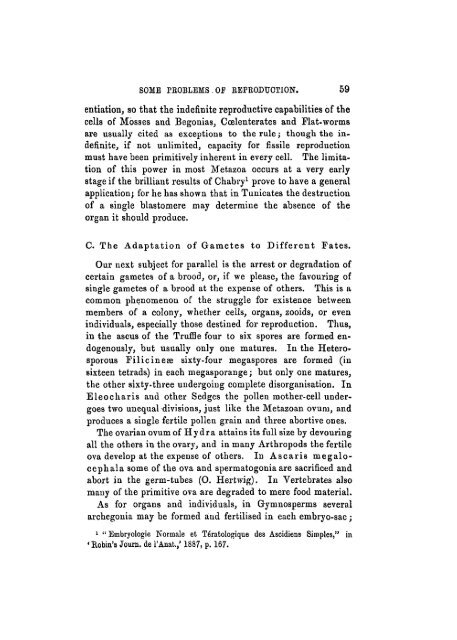Some Problems of Reproduction: a Comparative Study of ...
Some Problems of Reproduction: a Comparative Study of ...
Some Problems of Reproduction: a Comparative Study of ...
Create successful ePaper yourself
Turn your PDF publications into a flip-book with our unique Google optimized e-Paper software.
SOME EBOBLEMS.Of BEPRODUCTION. 59<br />
entiation, so that the indefinite reproductive capabilities <strong>of</strong> the<br />
cells <strong>of</strong> Mosses and BegoniaSj Coelenterates and Flat-worms<br />
are usually cited as exceptions to the rule; though the indefinite,<br />
if not unlimited, capacity for fissile reproduction<br />
must have been primitively inherent in every cell. The limitation<br />
<strong>of</strong> this power in most Metazoa occurs at a very early<br />
stage if the brilliant results <strong>of</strong> Chabry 1 prove to have a general<br />
application^ for he has shown that in Tunicates the destruction<br />
<strong>of</strong> a single blastomere may determine the absence <strong>of</strong> the<br />
organ it should produce.<br />
C. The Adaptation <strong>of</strong> Gametes to Different Fates.<br />
Our next subject for parallel is the arrest or degradation <strong>of</strong><br />
certain gametes <strong>of</strong> a brood, or, if we please, the favouring <strong>of</strong><br />
single gametes <strong>of</strong> a brood at the expense <strong>of</strong> others. This is a<br />
common phenomenon <strong>of</strong> the struggle for existence between<br />
members <strong>of</strong> a colony, whether cells, organs, zooids, or even<br />
individuals, especially those destined for reproduction. Thus,<br />
in the ascus <strong>of</strong> the Truffle four to six spores are formed endogenously,<br />
but usually only one matures. In the Heteror<br />
sporous Filicinese sixty-four megaspores are formed (in<br />
sixteen tetrads) in each megasporange; but only one matures,<br />
the other sixty-three undergoing complete disorganisation. In<br />
Eleocharis and other Sedges the pollen mother-cell undergoes<br />
two unequal divisions, just like the Metazoan ovum, and<br />
produces a single fertile pollen grain and three abortive ones.<br />
The ovarian ovum <strong>of</strong> Hydra attains its full size by devouring<br />
all the others in the ovary, and in many Arthropods the fertile<br />
ova develop at the expense <strong>of</strong> others. In Ascaris megalocephala<br />
some <strong>of</strong> the ova and spermatogonia are sacrificed and<br />
abort in the germ-tubes (0. Hertwig). In Vertebrates also<br />
many <strong>of</strong> the primitive ova are degraded to mere food material.<br />
As for Organs and individuals, in Gymnosperms several<br />
archegonia may be formed and fertilised in each embryo-sac;<br />
1<br />
" Embryologie Normale et T6ratologique des Asoidiens Simples," in<br />
'Robin's Jour». del'Anat./1887, p. 167.

















